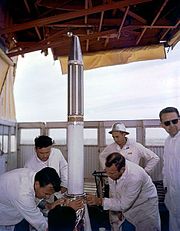
Sputnik 1 was the first artificial Earth satellite. It was launched into an elliptical low Earth orbit by the Soviet Union on 4 October 1957 as part of the Soviet space program. It sent a radio signal back to Earth for three weeks before its three silver-zinc batteries became depleted. Aerodynamic drag caused it to fall back into the atmosphere on 4 January 1958. The world's first observation was made at the school observatory in Rodewisch (Saxony).

The Space Race was a 20th-century competition between two Cold War rivals, the United States and the Soviet Union, to achieve superior spaceflight capability. It had its origins in the ballistic missile-based nuclear arms race between the two nations following World War II and had its peak with the more particular Moon Race to land on the Moon between the US moonshot and Soviet moonshot programs. The technological advantage demonstrated by spaceflight achievement was seen as necessary for national security and became part of the symbolism and ideology of the time. The Space Race brought pioneering launches of artificial satellites, robotic space probes to the Moon, Venus, and Mars, and human spaceflight in low Earth orbit and ultimately to the Moon.

Redstone Arsenal is a United States Army base adjacent to Huntsville, Alabama in the Wheeler National Wildlife Refuge. A census-designated place in Madison County, Alabama, United States, it is part of the Huntsville-Decatur Combined Statistical Area. The Arsenal is a host to over 75 tenant agencies including the Department of Defense (DoD), Department of Justice (DOJ), the Federal Bureau of Investigation (FBI), and NASA's largest field center, the Marshall Space Flight Center.
Project Vanguard was a program managed by the United States Navy Naval Research Laboratory (NRL), which intended to launch the first artificial satellite into low Earth orbit using a Vanguard rocket. as the launch vehicle from Cape Canaveral Missile Annex, Florida.

The Army Ballistic Missile Agency (ABMA) was formed to develop the U.S. Army's first large ballistic missile. The agency was established at Redstone Arsenal on 1 February 1956, and commanded by Major General John B. Medaris with Wernher von Braun as technical director.

The National Advisory Committee for Aeronautics (NACA) was a United States federal agency founded on March 3, 1915, to undertake, promote, and institutionalize aeronautical research. On October 1, 1958, the agency was dissolved and its assets and personnel were transferred to the newly created National Aeronautics and Space Administration (NASA). NACA is an initialism, i.e., pronounced as individual letters, rather than as a whole word.

The Sputnik crisis was a period of public fear and anxiety in Western nations about the perceived technological gap between the United States and Soviet Union caused by the Soviets' launch of Sputnik 1, the world's first artificial satellite. The crisis was a significant event in the Cold War that triggered the creation of NASA and the Space Race between the two superpowers. The satellite was launched on October 4, 1957, from the Baikonur Cosmodrome. This created a crisis reaction in national newspapers such as The New York Times, which mentioned the satellite in 279 articles between October 6, 1957, and October 31, 1957.

The Saturn family of American rockets was developed by a team of former German rocket engineers and scientists led by Wernher von Braun to launch heavy payloads to Earth orbit and beyond. The Saturn family used liquid hydrogen as fuel in the upper stages. Originally proposed as a military satellite launcher, they were adopted as the launch vehicles for the Apollo Moon program. Three versions were built and flown: the medium-lift Saturn I, the heavy-lift Saturn IB, and the super heavy-lift Saturn V.
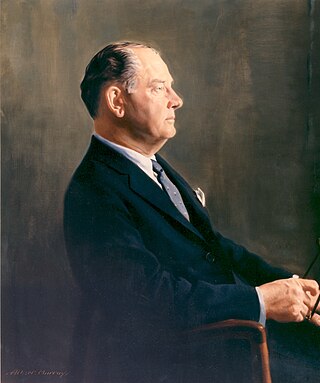
Thomas Keith Glennan was the first Administrator of the National Aeronautics and Space Administration, serving from August 19, 1958 to January 20, 1961.

George Michael Low was an administrator at NASA and the 14th president of the Rensselaer Polytechnic Institute. Low was one of the senior NASA officials who made decisions as manager of the Apollo Spacecraft Program Office in the Apollo program of crewed missions to the Moon.

Horton Guyford Stever was an American administrator, physicist, educator, and engineer. He was a director of the National Science Foundation.

The National Aeronautics and Space Act of 1958 is the United States federal statute that created the National Aeronautics and Space Administration (NASA). The Act, which followed close on the heels of the Soviet Union's launch of Sputnik, was drafted by the United States House Select Committee on Astronautics and Space Exploration and on July 29, 1958 was signed by President Eisenhower. Prior to enactment, the responsibility for space exploration was deemed primarily a military venture, in line with the Soviet model that had launched the first orbital satellite. In large measure, the Act was prompted by the lack of response by a US military infrastructure that seemed incapable of keeping up the space race.

Spaceflight began in the 20th century following theoretical and practical breakthroughs by Konstantin Tsiolkovsky, Robert H. Goddard, and Hermann Oberth, each of whom published works proposing rockets as the means for spaceflight. The first successful large-scale rocket programs were initiated in Nazi Germany by Wernher von Braun. The Soviet Union took the lead in the post-war Space Race, launching the first satellite, the first animal, the first human and the first woman into orbit. The United States caught up with, and then passed, their Soviet rivals during the mid-1960s, landing the first men on the Moon in 1969. In the same period, France, the United Kingdom, Japan and China were concurrently developing more limited launch capabilities.

The Guggenheim Aeronautical Laboratory at the California Institute of Technology (GALCIT), was a research institute created in 1926, at first specializing in aeronautics research. In 1930, Hungarian scientist Theodore von Kármán accepted the directorship of the lab and emigrated to the United States. Under his leadership, work on rockets began there in 1936. GALCIT was the first—and from 1936 to 1940 the only—university-based rocket research center. Based on GALCIT's JATO project at the time, the Jet Propulsion Laboratory was established under a contract with the United States Army in November 1943.

Milton William Rosen was a United States Navy engineer and project manager in the US space program between the end of World War II and the early days of the Apollo Program. He led development of the Viking and Vanguard rockets, and was influential in the critical decisions early in NASA's history that led to the definition of the Saturn rockets, which were central to the eventual success of the American Moon landing program. He died of prostate cancer in 2014.

The Redstone family of rockets consisted of a number of American ballistic missiles, sounding rockets and expendable launch vehicles operational during the 1950s and 1960s. The first member of the Redstone family was the PGM-11 Redstone missile, from which all subsequent variations of the Redstone were derived. The Juno 1 version of the Redstone launched Explorer 1, the first U.S. orbital satellite in 1958 and the Mercury-Redstone variation carried the first two U.S. astronauts into space in 1961. The rocket was named for the Redstone Arsenal in Huntsville, Alabama where it was developed.

The space policy of the United States includes both the making of space policy through the legislative process, and the implementation of that policy in the United States' civilian and military space programs through regulatory agencies. The early history of United States space policy is linked to the US–Soviet Space Race of the 1960s, which gave way to the Space Shuttle program. At the moment, the US space policy is aimed at the exploration of the Moon and the subsequent colonization of Mars.
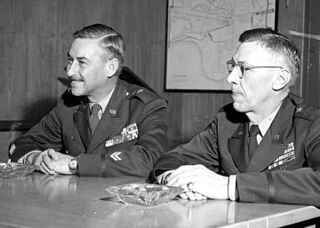
John Bruce Medaris was an officer in the United States Army during World War II and post-war government administrator overseeing development of ballistic missiles.
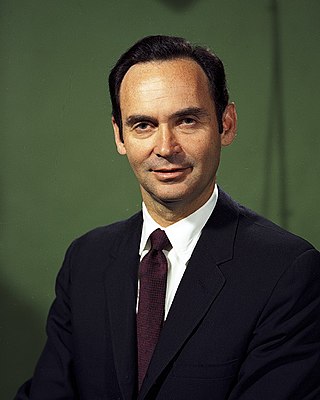
Harold Benjamin Finger is an American aeronautical nuclear engineer and the former head of the United States nuclear rocket program. He helped establish and lead the Space Nuclear Propulsion Office, a liaison organization between NASA and the Atomic Energy Commission to coordinate efforts to create a nuclear thermal rocket.
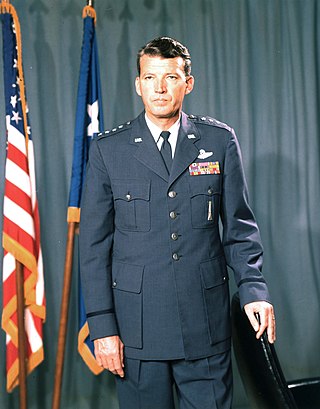
While the United States Space Force gained its independence on 20 December 2019, the history of the United States Space Force can be traced back to the beginnings of the military space program following the conclusion of the Second World War in 1945. Early military space development was begun within the United States Army Air Forces by General Henry H. Arnold, who identified space as a crucial military arena decades before the first spaceflight. Gaining its independence from the Army on 18 September 1947, the United States Air Force began development of military space and ballistic missile programs, while also competing with the United States Army and United States Navy for the space mission.
